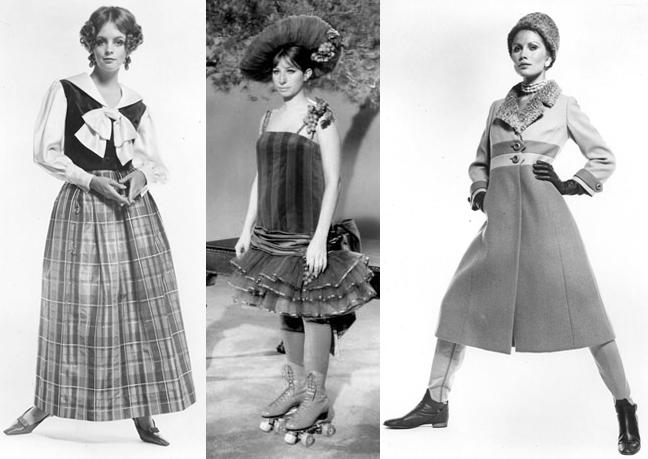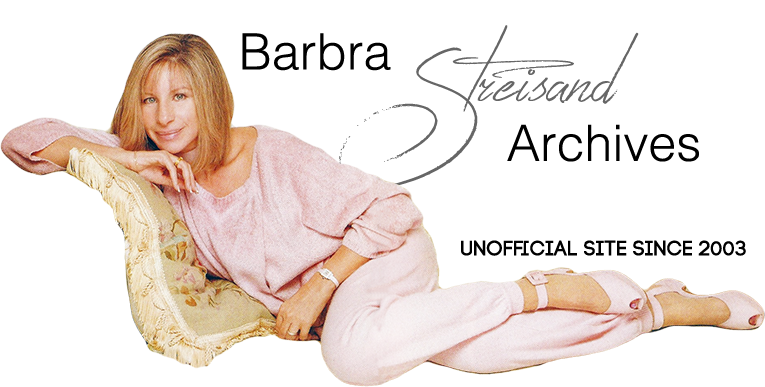Fashions Do Repeat
August 1, 1968

Left to right:
ROMANTIC — In the Funny Girl collection is this silk taffeta skirt, hostessing a middly silk-faced satin credpe blouse and emerald velveteen weskit by Mr. Gee. It's for at-home.
STAR — Barbra Streisand models a velvet and tulle flapper dress for her movie role of Fanny Brice in Funny Girl, to be released this fall. Grapes accessorize.
LIBERATED — The great coat era of Funny Girl, stage-struck with "suffrage" length hemlines is Dan Millstein's creation in dual toned worsted twill with Persian lamb.
When Funny Girl, the film based on Fanny Brice's life story, opens this autumn with Barbra Streisand in the star role, chic women in the audience may think they're seeing themselves in a mirror.
Of the four decades during which Fanny Brice shone as one of the brightest luminaries of the stage and radio, at least three—the 19-teens, 1930s and 1940s—have once again become part of "the look" of today.
To point up this fashion fact, Eleanor Lambert, coordinator of the American Designer Showings, was asked by Columbia Pictures and Ray Stark (who conceived and produced both the play and the film about his mother-in-law), to choose from the collections of the noted designers in the recent press week collections a few costumes in the mood of the Fanny Brice epoch from her early years on Henry Street to her heyday as a Follies star.
Even her famous "I am an Indian" and "Baby Snooks" get into the act via Adolfo's fringed suede Indian dress and George Halley's million-dollar-baby dress of silver metallic knit.
A long lanky suit with an inset belt, a "suffrage length" coat costume and an ice-skating skirt and stocking cap with 19-teens influence were shown. Aldofo's ice-skating skirt of banded felt, vestee top and striped hand-knitted, tasselled stocking cap could have stepped right out of a faded 1916 photograph. And elongated, belted country sweater and tweed knickers by Jerry Feder of Hadley completed the Henry Street group.
A red Kimberly suit is typical up-dating of the long jacket straight but wasted shape of the 19-teens.
The "suffrage length" of World War I was brought up to next winter in Chester Weinberg's taupe and henna fitted coat and jumper dress with a paisley blouse.
The 1930s, when sex and the Follies Girl were interchangeable fashion symbols was represented in the high fashion sampling by a willowy bias cut platinum grey silk dress by Bill Blass. It was loaded with platinum fox.
The Oscar de la Renta brown and white woven patterned wool steamer cape and dress, was followed by a rampant array of feathers and beads straight off the golden stairway of the "Ziegfeld Follies."
The ultra-chic 1940s brought in sleek trouser costumes (Marlene Dietrich helped), padded shoulders and padded hips (The New Look), jumper dresses and devastating black body beautiful costumes (shades of Kay Francis, Rita Hayworth, and Ginger Rogers) and daring necklines on full evening dresses.
The 1966-69 updating of these silhouettes included Donald Brooks' lynx-bordered, wide shouldered Dietrich pants suit, Goeffrey Beene's black belted suit with hip padding, John Moore's black crepe dress with a gorgeous "throw" of crepe edged in black fox and Oscar de La Renta's svelte black velvet pajamas edged in gold bullion scallops.
Blame Funny Girl for '69 fashions
December 17, 1968
by Margaret Ness
Fashion has again been influenced by a movie. Remember the desert helmets and swathed veiling that followed the release of Lawrence of Arabia? And the long-coated Cossack look—still with us—of Dr. Zhivago and War and Peace, or the berets and sweater-jackets of Bonnie and Clyde?
Now the latest movie influence comes from the current Funny Girl, starring Barbra Streisand and based on the life of comedienne Fanny Brice.
For the last few years top New York designers have been flirting with the fashions of the 1920s and '30s. It was an idea here, a steal from there—more a mood than an influence. Then came Bonnie and Clyde, but this was limited in appeal. Bonnie Parker's outfits were too dated and most unbecoming for many young women. Now we're in for a whole pre-war fashion scope, and you'll know where to place the blame or commendation, depending on your personal viewpoint: Smack on Funny Girl.
The movie is the life story of the girl whose rise to fame as a star in the Ziegfeld Follies spanned the period from 1912 into the 1930s. Miss Brice herself was a great fashion influence. In private life, she wore smart clothes by influential designers, and most extravagant creations for the Follies.
Naturally, in re-creating Fanny's life, Miss Streisand wears clothes typical of the era. These have a direct bearing on a number of trends in the winter collections in New York and will, of course, be seen in the Canadian market too.
You may not always recognize the movie source, so here are a few pointers. For one thing, there's the steamer cape-coat, its wrap bulk as important then to travellers as are our spare knit coats for today's planes. Several top designers have included it in their collections, and Oscar de la Renta introduces it in a brown-and-white zigzag weave, with a huge stole.
Since this is also the period of the early Gertrude Lawrence stage successes, this steamer coat is in the collection of Donald Brooks, the designer responsible for the wardrobe in Star, the movie version of Miss Lawrence's life, with Julie Andrews. Brooks' modern steamer coats include a blanket cloth in huge black-and-white squares with a black Persian lamb collar.
There is a definite North American Indian influence in a number of the collections, traceable to Miss Brice's famous "I am an Indian" act. In this mood, El Greco designed a sleeveless and wrapped beige buckskin tunic and mid-calf wrap skirt, complete with headband. Jacques Tiffeau created a black-and-gold brocade dinner suit in bands with a vaguely Indian motif. To emphasize the origin there was a matching black-topped Indian headband. A fringed suede was used by Lyn Stuart for a bolero-vest and short pants, with Indian embroidery on the white crepe shirt.
The young Fanny Brice—she was 19 in 1912—wore sailor collars, knitted berets, and ribbed knit stockings. The sailor suit look is back again in 1968 dresses, especially for the school set. Berets in leather as well as knits are the millinery love from from pre-teens to matrons.
In Fanny's starring years there were lots of feathers and shaggy furs; and feathers have made their periodic dramatic return this fall. Teal Traina, for example, introduced a whole ostrich jacket, directly inspired by one worn in the movie.
Other designers were also in the feather-laden mood of Ziegfeld's famous stairway beauties. Gayle Kirkpatrick included vests and skirts of coq feathers in his evening collection. Geoffrey Beene's sequined bodice was attached to a floor-length skirt of ostrich pouffes. And Mam'selle tied her short skirt of black ostrich fronds and black chiffon top with a pink satin sash.
End.
Related Pages:
[ top of page ]
